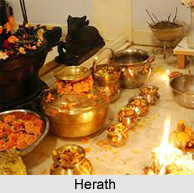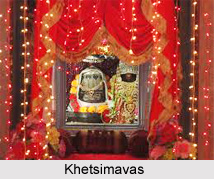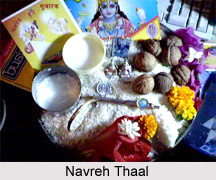 Importance of Kashmiri Pandit Festivals defines the culture of Kashmiri Hindus, which have a slow similarity with the Jewish people.
Importance of Kashmiri Pandit Festivals defines the culture of Kashmiri Hindus, which have a slow similarity with the Jewish people.
The religious festivals of the Brahmins of Kashmir have Rig Vedic and Proto-Indo-Iranian roots. Kashmiri Pandits share most of their festivals with other Hindu communities and some other peoples whose cultures are derived from the Proto-Indo-Iranian religion.
Some of the Kashmiri Pandit festivals are Herath (Shivaratri), Navreh, Zyeath-Atham (Jyeshtha Ashtami), Huri-Atham (Har Ashtami), Zarmae-Satam (Janmashtami), Dussehra, Diwali, Pan (Roth Puza / Vinayaka Tsoram / Ganesha Chaturthi), Gaad Batt, Khetsimavas (Yakshamavasya), Kava Punim, Mitra Punim, Tiky Tsoram, Gengah Atham, Tila Atham, Vyetha Truvah, and Anta Tsodah.
Herath
Herath comprises elaborate the Tantric rituals that involve observance of a fast during the day and performance of a yagna or fire sacrifice at night. Choice dishes, mainly of meat and fish but also vegetarian as an option, are cooked as sacrificial food and partaken of by the worshipper and his family after being symbolically offered to the whole host of deities and attendant deities associated with Shivaratri. The imagery of the anionic earthen images, vagur, sonipotul and others representing Lord Shiva, Lord Ganesha, Parvati, yoginis and kshetrapalas, is not clear, as no available text has cared to have thrown any light on it. The vagur, specially worshipped on the dvadashi night itself, is perhaps a vestige of the rites of the Kaula cult as the manual on Shivaratri suggests.
Navreh
Kashmiri Pandits celebrate their New Year"s Day on the first day of the bright half of the month of Chaitra and call it Navreh - the word "navreh", derived from the Sanskrit "nava varsha", literary meaning "new year". The Kashmiri Pandit families that migrated to the plains before 1900 also celebrate Navreh with great pride. On the eve of Navreh, a platter of unhusked rice with a bread, a cup of yogurt, a little salt, a little sugar candy, a few walnuts or almonds, a silver coin, a pen, a mirror, some flowers (rose, marigold, crocus, or jasmine) and the new panchanga or almanac is kept and seen as the first thing on waking up in the morning. This ritual is more or less the same as the Haft Sin of the Iranian and Zoroastrian Nowruz.
 The Bhringisha Samhita says that the platter should be of bronze (kansyapatraka). The same ritual is observed on Sonth or the Kashmiri spring festival. The Saptarshi Era of the Kashmiri Hindu calendar is believed to have started on this very day, some 5079 years ago. According to the legend, the celebrated Sapta Rishis assembled on the Sharika Parvata (Hari Parbat), the abode of the goddess Sharika, at the auspicious moment when the first ray of the sun fell on the Chakreshvara on this day and paid tribute to her. Astrologers made this moment as the basis of their calculations of the nava varsha pratipada, marking the beginning of the Saptarshi Era. Before their exodus Kashmiri Pandits would flock to Hari Parbat in thousands to celebrate Navreh.
The Bhringisha Samhita says that the platter should be of bronze (kansyapatraka). The same ritual is observed on Sonth or the Kashmiri spring festival. The Saptarshi Era of the Kashmiri Hindu calendar is believed to have started on this very day, some 5079 years ago. According to the legend, the celebrated Sapta Rishis assembled on the Sharika Parvata (Hari Parbat), the abode of the goddess Sharika, at the auspicious moment when the first ray of the sun fell on the Chakreshvara on this day and paid tribute to her. Astrologers made this moment as the basis of their calculations of the nava varsha pratipada, marking the beginning of the Saptarshi Era. Before their exodus Kashmiri Pandits would flock to Hari Parbat in thousands to celebrate Navreh.
Zyeth Atham
On Zyeth Atham or the eighth day of the bright half of Jyeshtha (May-June) a grand festival is held at Tulmul to celebrate the pradurbhava of the Goddess. Another festival is held at the shrine on Asharha Ashtami with equal devotional fervour, the sacred spring of the shrine that miraculously changes its colour having been discovered on the saptami of that month. The devotees offer their worship, individually or in groups, waving lamp (dipa) and burning incense (dhupa) while reciting hymns to the Goddess and singing devotional songs. They make offerings of khir to her and of milk, loaf-sugar and flowers, which they offer into the spring. Ritually no specific procedure is prescribed for the Puja at Kshir Bhavani.
Tiky Tsoram
Tripura Sundari is one of the most important goddesses worshipped in the Tantric tradition in Kashmir. Her cult is particularly popular among the Tiku clan of Kashmiri Pandits who celebrate her festival on Tiky chorum (4th.maag one day before Vasant Panchami). The surname "Tiku" is derived from "trika", according to popular etymology. Her devotees believe that she combines in her form all three Goddesses, Mahalakshmi, Maha-sarswati and Mahakali, and all three of her cosmic functions. However, she is also worshipped by the entire Brahmin community in Kashmir and from very early times.
 Pan
Pan
Pan is a festival originally associated with the spinning of newly produced cotton and worshipping the twin agricultural goddesses, obviously local, Vibha and Garbha to whom roths or sweet bread cakes were offered. Though Kashmir is not said to have a climate suitable for growing cotton, there is a strong tradition suggesting that it actually did grow there. The festival falls on the Ganesh Chaturthi (Vinayaka Tsoram) day and the worship of Lakshmi on this occasion seems to have been inducted later. Not that the worship dedicated to the local goddesses was appropriated wilfully by followers of the cult of Lakshmi, but there appears to have been a mix-up at some point of time. The twin goddesses themselves seem to have merged into one another assuming the identity of the folk deity Beeb Garabh Maj, whose very name- obviously a distortion - points to such a possibility. Beeb Garabh Maj is represented by a lota or a water pot which is placed in the centre of the place where the Puja is to be performed, a cotton thread being tied to its neck and handful of dramun or runner grass kept inside it, pointing again to its agricultural origin.




















